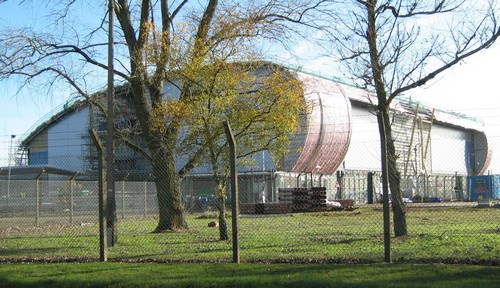
Orion laser under construction at AWE Aldermaston (Nov 07)
Press release.
Embargo: not for release until 16th Nov 2007
Nuclear bomb factory emergency rehearsals inadequate to protect public
A report by the independent research group Nuclear Information Service (NIS), released the same week that Britain’s nuclear bomb factory at Aldermaston prepares for a major test of its emergency procedures, highlights a series of flaws in previous emergency exercises at the site which the authors believe would leave members of the public and personnel working at the site at risk in the event of an accident.
Restricted official documents released under the Freedom of Information Act show that two of the six emergency exercises held by the Atomic Weapons Establishment (AWE) over the period January 2006 – September 2007 were unable to demonstrate that the emergency response to the accident scenarios played out in the exercises were sufficient to meet the objectives of the exercises. AWE was ordered to repeat the exercises by the Health and Safety Executive’s Nuclear Directorate (HSE ND), the government’s regulator of nuclear safety.
NIS reviewed post exercise reports and observations made by HSE ND observers for six exercises held at AWE’s nuclear weapons manufacturing sites at Aldermaston and Burghfield over the 21 month period. They concluded that emergency management would not always have been sufficient to protect casualties, emergency responders, and possibly the general public, had the exercise been a real emergency.
At each site an emergency exercise had to be repeated because HSE considered that it did not demonstrate an adequate emergency response. An exercise held at Burghfield on 5th December 2006 revealed shortfalls in contamination monitoring and control arrangements, and an exercise which took place at Aldermaston on 21st May 2007 failed to demonstrate that AWE would be able to cope with an out of hours emergency on the site.
NIS believes that AWE’s post exercise review reports reveal a consistent pattern of problems in accounting for all staff working on site; issuing information and instructions using on-site public address systems; and controlling the spread of radioactive contamination from the location of an incident.
None of the emergency exercises described in the papers which were released involved members of the public or the Royal Berkshire Hospital - a key stakeholder - or tested technical engineering responses and site recovery arrangements following an accident.
The Aldermaston nuclear bomb plant, together with police, fire-fighters, ambulance crews, and local authorities is scheduled to carry out its next emergency exercise on Friday 16th November to test liaison arrangements in the event of an accident leading to an off-site release of radioactivity.
Di McDonald, Director of NIS said: “The review documents for the exercises at AWE have highlighted a number of concerns and we believe they show that emergency management would not always have been sufficient to protect casualties, emergency responders, and possibly the general public, had the exercise been a real emergency.
“The documents show that, far from protecting us, nuclear weapons add to the risks that the public faces”.
For more information please contact Di McDonald of Nuclear Information Service on 02380 554434.
Ends.
Source:
 http://www.nuclearinfo.org/sites/awe/article/249
http://www.nuclearinfo.org/sites/awe/article/249 
 Homepage:
Homepage:
Comments
Display the following comment